Belfast in amazing rare color photographs, 1955

These amazing color photographs of Belfast capture the shipyards, vibrant streets, everyday life, fashion, and document the world of a city we know today. The photographs were taken by documentary and press photographer, Burt Hardy, who is best known for his work in Picture Post magazine.
There is a romance of long forgotten times when the Belfast trams still operated, and steam trains roared to Derry, Enniskillen and Newcastle, while the Fintona Horse Tram was still in operation. There were only 60,000 phones so telegrams, letters and postcards remained important for communication.
There were still 50,000 horses on Ulster farms and they remained an important element in urban transport and were overtaken by 54,000 cars. In the home, central heating and double glazing were almost unheard of, and very few homes had fridges.
The years between 1880 and the outbreak of the Great War were Belfast's golden age of shipbuilding. Belfast shipbuilders accounted for about 8 percent of world production in 1914.
In a few years Belfast was able to achieve an even greater percentage of world production. A Financial Times supplement in March 1914 described Belfast as 'the world's leading shipbuilding centre'.

In the early twentieth century there were two great shipyards in Belfast: Harland & Wolff & Workman, Clark & Co. The first was the 'Big Yard', while the latter was affectionately known as the 'Wee Yard'. Before the outbreak of the Great War in 1914, more than 25,000 men worked at the Belfast Yard, but by 1933 this had reduced to less than 3,000.
In the lead-up to World War II, work intensified at the Belfast shipyard. During the war, Harland & Wolfe Shipyard began producing ships at a rate not seen after the Great War or since the Golden Age of Victorian shipbuilding. As orders from the British Admiralty arrived, employment again rose to over 20,000 men.
Their production included gunboats, depot ships, monitors, cruisers, destroyers, aircraft carriers, patrol boats, trawlers, minesweepers, corvettes, tankers and attack ships.
The workforce peaked in the post-war years, but by the late 1950s, the yard was facing the effects of global competition and the rise of air travel.
The introduction of Canberra in 1960 marked the last cruise liner to be built in Belfast, and by the middle of the decade, business was in serious decline. The following decades saw further communal disturbance in the yard and a steady decline in the number of ships built.




No comments: